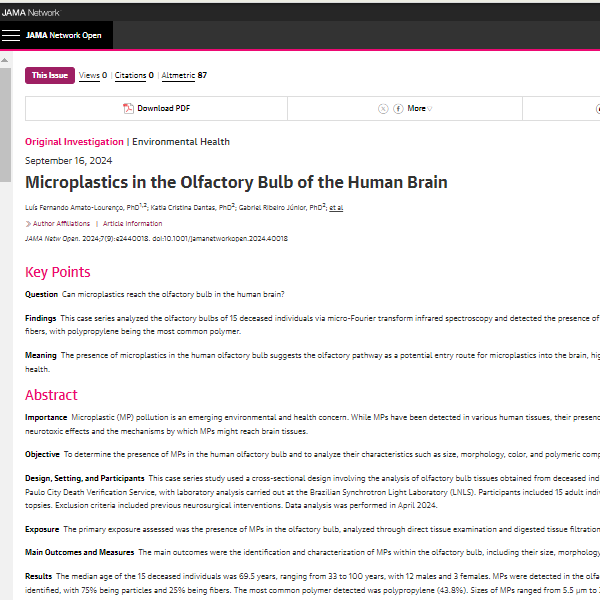
Presence of microplastics in human stomachs
This study presents the first definitive confirmation of microplastic presence in the human stomach, based on samples from 26 cadavers. 97 microplastic particles were extracted from stomach contents, across all 26 individuals, revealing a universal prevalence of microplastics in the cadavers.

Association of mixed exposure to microplastics with sperm dysfunction: a multi-site study in China
Our findings highlight the potential reproductive health risks posed by microplastic contamination, particularly PTFE, a non-stick pan coating material, and raise concerns about the potential of urine testing as an indicator of male reproductive microplastic exposure. Future research is warranted to further elucidate the mechanisms underlying the adverse effects of microplastics on male fertility and cross-generational effects.

Microplastics in the Olfactory Bulb of the Human Brain
This case series provides evidence of MPs found in the human olfactory bulb, suggesting a potential pathway for the translocation of MPs to the brain. The findings underscore the need for further research on the health implications of MP exposure, particularly concerning neurotoxicity and the potential for MPs to bypass the blood-brain barrier.

Discovery and analysis of microplastics in human bone marrow
Pyrolysis-gas chromatography-mass spectrometry (Py-GC/MS) is an emerging thermal analysis technique that reliable qualified and quantified data for MPs risk assessment of human health [15], [26]. Laser direct infrared spectroscopy (LD-IR) has been widely used to characterize of MPs, including their type, size, and morphology [12]. This study utilized Py-GC/MS, LD-IR, and scanning electron microscopy (SEM) to analyze and identify the accumulation of MPs in the bone marrow. The results provide crucial data for evaluating the risks of MPs on human haematopoietic injury, and support further studies with larger sample sizes and more detailed designs to explore the health implications of MPs in human bone marrow.

Bioaccumulation of Microplastics in Decedent Human Brains Assessed by Pyrolysis Gas Chromatography-Mass Spectrometry
Rising global concentrations of environmental micro- and nanoplastics (MNPs) drive concerns for human exposure and health outcomes. Applying pyrolysis gas chromatography-mass spectrometry (Py-GC/MS) methods to isolate and quantify MNPs from human samples, we compared MNP accumulation in kidneys, livers, and brains.

State of the Science On Plastic Chemicals
Although there is a wealth of scientific information on plastic chemicals and polymers to inform policymakers, implementing this evidence is challenging because information is scattered and not easily accessible. The PlastChem report and database address this issue by comprehensively and consistently synthesizing the state of the science on plastic chemicals, including their hazard properties, and their presence in polymers. The state-of-the-science report provides the publicly available evidence to inform policy development that protects public health and the environment.

Microplastics and Nanoplastics in Atheromas and Cardiovascular Events
Plastic waste is a growing problem, and as plastics break down the pieces can be problematic. A new study in Science Advances suggests that tiny plastic particles may be the latest environmental contributor to Parkinson’s disease (PD)

Identification and analysis of microplastics in human lower limb joints
Our findings demonstrate the presence of MPs in human joints and suggest that further studies are needed to explore the intricate associations between MPs and anatomical location, clinical diagnosis, and local cellular responses.

Hazardous Chemicals in Recycled and Reusable Plastic Food Packaging
All types of water pipes, not only lead, can release chemicals into drinking water. Plastic pipes, which are constructed from potentially dozens of different chemicals, release more contaminants into drinking water than unlined metal pipes, which are built of few materials. Communities need to understand the potential health risks associated with different water pipe materials so that they do not end up with what’s known as a “regrettable substitution,” or a situation in which a selected alternative turns out to be just as bad, if not worse, as the original option.

The Perils of PVC Plastic Pipes
All types of water pipes, not only lead, can release chemicals into drinking water. Plastic pipes, which are constructed from potentially dozens of different chemicals, release more contaminants into drinking water than unlined metal pipes, which are built of few materials. Communities need to understand the potential health risks associated with different water pipe materials so that they do not end up with what’s known as a “regrettable substitution,” or a situation in which a selected alternative turns out to be just as bad, if not worse, as the original option.

PVC Poison Plastic
Every day, PVC production exposes communities around the country to vinyl chloride and other PVC chemicals, a result of the inadequate U.S. regulatory system that allows the use of the most hazardous chemicals and plastics. This investigation uncovers the largest polluters of vinyl chloride in the U.S. and maps the communities regularly exposed to this dangerous chemical and its waste products.

The Minderoo-Monaco Commission on Plastics and Human Health
The Minderoo-Monaco Commission on Plastics and Human Health has produced an extensive analysis of the plastics’ negative impacts on: i) human health and well-being focusing on vulnerable populations, ii) on the global environment focusing on ocean health, and iii) the economy. The report includes highly valuable sustainable solutions that can be implemented by governments and industries to minimize the negative consequences of global plastic contamination This is an urgent problem that must be addressed in the worldwide agenda in parallel to climate change, as they are closely interconnected.

